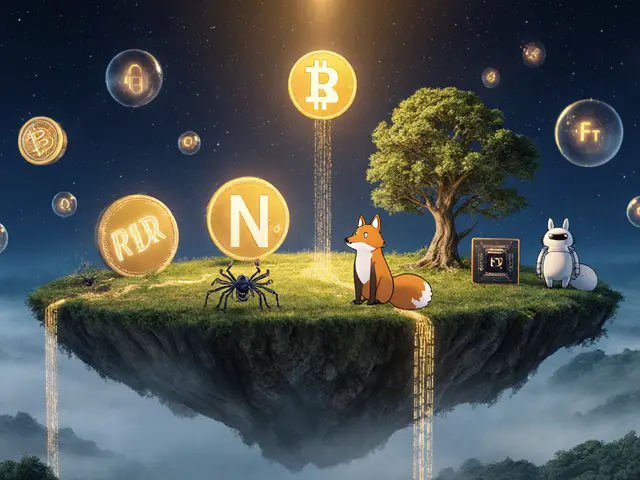18
DePIN Token Economics: How Blockchain Incentives Power Real-World Infrastructure

DePIN Profitability Calculator
Node Profitability Calculator
Calculate your potential earnings from running a DePIN node
Results
Total Hardware Cost:
Total Electricity Cost:
Total Earnings:
Profit/Loss:
Break-even Point:
Most people think crypto is just about speculation-buying coins hoping they’ll go up, then selling before the crash. But there’s a quieter, more powerful shift happening: DePIN is turning blockchain into a real economic engine for physical infrastructure. Think of it like Uber or Airbnb, but instead of cars or rooms, you’re renting out Wi-Fi hotspots, computer power, or air quality sensors-and getting paid in tokens for it.
What Exactly Is DePIN?
DePIN stands for Decentralized Physical Infrastructure Networks. It’s not a theory. It’s hardware plugged into your home or business, connected to a blockchain, and earning tokens for providing real services. The first big example was Helium, launched in 2013. People bought $200 hotspots, put them in their windows, and started earning HNT tokens every time their device helped connect IoT devices like smart meters or pet trackers to the internet. No middleman. No telecom company. Just a global, user-owned wireless network.Today, there are over 75 active DePIN projects. Together, they’re worth more than $8.2 billion. And unlike meme coins that rise on Twitter hype and crash when the trend dies, DePIN projects have real customers paying for actual services. Helium made $28.3 million from enterprise clients in just one quarter of 2024. Filecoin earns millions monthly from companies storing data on its decentralized cloud. These aren’t fantasy numbers-they’re bank statements.
How Do DePIN Tokens Actually Work?
DePIN token economics isn’t about pumping a coin. It’s about aligning incentives. The system has five moving parts:- Supply and Distribution: Tokens aren’t all dumped on the market. Typically, 40-50% go to users who provide infrastructure. Another 15-20% are locked up for the team over 3-4 years. Treasury funds (10-15%) pay for development. The rest (15-20%) reward early adopters and community growth.
- Incentive Structures: You earn tokens for doing things that help the network. Staking your tokens? You might get 5-20% annual yield. Running a hotspot or GPU node? You get paid per gigabyte of data transferred or computation done. Participating in governance? Your voting power scales with how many tokens you hold.
- Token Utility: Tokens aren’t just tradeable assets. On Helium, 1 HNT = 1 data credit. You need HNT to pay for network usage. On Render Network, you spend RENDER tokens to rent GPU power for 3D rendering. On IoTeX, you use IOTX to pay for sensor data from smart city devices. The token is the currency of the network.
- Governance: Decisions about upgrades, fees, or new features aren’t made by a CEO. They’re voted on by token holders. Projects like Helium use a three-tier system: HNT holders elect validators, who then vote on technical proposals. Others use quadratic voting to prevent rich holders from dominating.
- Buy-and-Burn: This is where DePIN gets smart. Projects like IoTeX take 30% of all service revenue and use it to buy back and destroy IOTX tokens. Since Q1 2023, this has reduced the total supply by 2.1% per year. Less supply + steady demand = upward pressure on price, without needing hype.
Why DePIN Beats Meme Coins and Pure DeFi
Dogecoin and Shiba Inu have no revenue. No customers. No products. Just speculation. That’s why their prices swing wildly. DePIN is different because it’s backed by real-world demand.Filecoin’s FIL token stayed stable during the 2022 crypto crash because it was generating $12.7 million in quarterly revenue from real businesses storing data. DePIN tokens outperformed the broader crypto market by 67% in 2023 when you adjust for volatility. Why? Because they’re not gambling-they’re investing in infrastructure that people actually use.
Compare that to DeFi protocols like Uniswap or Aave. They’re great for trading and lending-but they’re all digital. DePIN connects the digital world to the physical one. You can’t run a wireless network or a distributed supercomputer without hardware. That’s the key. DePIN solves a real problem: how to build infrastructure at scale without big corporations.

Who’s Winning and Who’s Failing?
The leaders are clear:- Helium: 22% market share. Moved to Solana in August 2024, boosting speed from 10 transactions per second to 65,000. Now supports everything from smart agriculture to industrial sensors.
- Filecoin: 18% market share. Launched FVM (Filecoin Virtual Machine) in July 2024, letting developers build smart contracts on top of storage. Now used by universities, media companies, and government archives.
- Render Network: 15% market share. Lets users rent out GPU power for AI training and 3D rendering. Artists and developers pay in RENDER tokens to render complex scenes faster and cheaper than AWS.
But not all projects survive. Reddit user u/NodeNovice spent $450 on Render Network hardware, only to earn $18.50 a month after electricity costs. Why? Demand was inconsistent. Another user lost $1,200 on a DePIN project that vanished-its team abandoned it, the token dropped to zero, and the hardware became a paperweight.
Success comes down to two things: consistent demand and transparent revenue. Messari’s Ryan Watkins says the most trustworthy DePIN projects are the ones that verify income on-chain. If a project claims it earned $1 million from clients, but you can’t see the payments on the blockchain, it’s a red flag. Buy-and-burn mechanisms make this transparent-every token destroyed is public record.
The Hard Parts: Hardware, Regulation, and Complexity
DePIN isn’t easy. You can’t just download an app and start earning. You need hardware. A basic air quality sensor might cost $50. A high-end GPU node for Render Network? $2,000+. And you’ve got to keep it running 24/7, paying electricity bills.According to a July 2024 survey, 63% of new providers struggle with network setup. 71% say earnings are inconsistent. And 82% are confused about legal rules. In 67 countries, there’s no clear law on whether running a DePIN node counts as a business, a utility, or a hobby. Tax authorities don’t know how to classify token earnings.
That’s why only the most resilient projects survive. Helium’s Discord has 48,000 members and answers questions in under 17 minutes. Newer projects? Their documentation is patchy, their support is slow, and their tokens vanish when the team loses interest.

The Future: Consolidation and Real-World Adoption
The DePIN market hit $4.7 billion in 2023. It’s projected to hit $22.3 billion by 2027. But here’s the catch: Messari predicts 70% of current projects will fail by 2026. Why? Because the bar is rising. Investors aren’t just looking for hype anymore-they want revenue, transparency, and scalability.Fortune 500 companies are already using DePIN. 38 of them, according to Gartner. Most use it for IoT connectivity (62%) or distributed computing (28%). Think of a shipping company tracking containers globally with low-power sensors, or a hospital storing medical images on a decentralized network that can’t be hacked or shut down.
What’s next? More specialized networks: energy grids powered by peer-to-peer solar sharing, transportation networks where drivers earn tokens for sharing real-time traffic data, even clean air networks where cities pay residents to monitor pollution levels.
The winners won’t be the ones with the flashiest websites. They’ll be the ones with the most reliable hardware, the clearest token utility, and the most honest revenue reporting. If you’re thinking about joining a DePIN project, ask yourself: Is this earning real money from real customers? Can I see the payments on the blockchain? Is the team still active? If the answer’s yes, you might be looking at the future of infrastructure-not just crypto.
Is DePIN Right for You?
If you’re tech-savvy, have spare hardware, and want to earn passive income from something tangible-DePIN could be worth your time. But don’t treat it like a lottery. Track your costs: electricity, hardware depreciation, time spent troubleshooting. Only invest what you can afford to lose.For developers and entrepreneurs: DePIN opens up new business models. Build a service on top of Filecoin’s storage. Create an app that uses Helium’s global network. The infrastructure is there-you just need to build on it.
For everyone else: You don’t need to run a node. But you’re already using DePIN. If your smart thermostat connects to the internet without a carrier, it’s probably using Helium. If your company stores data securely without AWS, it might be on Filecoin. DePIN isn’t coming. It’s already here.
What is the main difference between DePIN and regular crypto projects?
Regular crypto projects, like meme coins or DeFi platforms, operate entirely in the digital world-they rely on speculation or peer-to-peer financial transactions. DePIN, on the other hand, ties blockchain incentives to real-world physical infrastructure. Users earn tokens by providing tangible services like internet coverage, computing power, or environmental data collection. This creates actual revenue from non-crypto customers, making DePIN less speculative and more like a utility business.
Can you make money running a DePIN node?
Yes, but it’s not guaranteed. Some users earn hundreds or even thousands per year-like one Helium hotspot owner who made $1,842 in HNT after electricity costs over three years. Others, especially on newer or low-demand networks, earn very little after accounting for power and hardware depreciation. Success depends on location, demand for the service, and network efficiency. Always calculate your break-even point before investing in hardware.
Are DePIN tokens a good investment?
They can be, but not because they’ll skyrocket overnight. DePIN tokens are better viewed as equity in a real infrastructure business. Projects with consistent revenue, transparent on-chain earnings, and buy-and-burn mechanisms (like IoTeX and Filecoin) have shown stronger long-term price stability. Avoid tokens with no clear utility, no revenue tracking, or teams that don’t communicate. The market is filtering out hype-only projects with real value will survive.
What hardware do I need to start with DePIN?
It varies by project. For Helium-style wireless hotspots, you need a $50-$200 device that connects to power and internet. For Render Network or other GPU-based networks, you need a high-end graphics card (like an RTX 4090), which can cost $1,500-$2,500. Some projects use simple sensors ($50-$100) for environmental monitoring. Always check the official documentation-hardware requirements and power consumption are critical to calculating profitability.
Is DePIN legal?
Regulation is still unclear in most places. As of October 2024, 67 countries have no specific laws covering DePIN. In some places, earning tokens from a node might be considered taxable income or even a financial service. In others, it’s treated like a hobby. Always consult a local tax professional. The lack of regulation is a risk-but also an opportunity for early adopters who understand compliance.
What happens if a DePIN project fails?
If the team abandons the project, the token usually crashes to zero, and the network stops functioning. Your hardware becomes useless unless it’s compatible with another network. That’s why it’s crucial to invest in established projects with active communities, transparent revenue, and on-chain verification. Avoid projects that don’t show proof of customer payments or have vague roadmaps. DePIN is built on trust-and if the trust breaks, so does the value.
How do DePIN projects make money if users are earning tokens?
They charge customers-businesses, governments, or individuals-for using the network. For example, a company might pay Filecoin to store data, or a city might pay Helium to connect thousands of smart sensors. The project takes a small fee from these payments, then uses part of that revenue to reward network participants with tokens. The rest funds development, marketing, and treasury reserves. It’s like a subscription service where the users are both customers and contributors.








